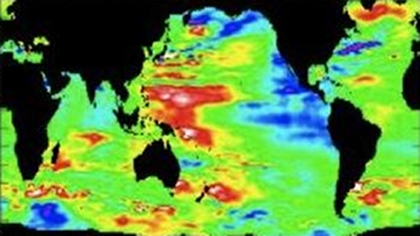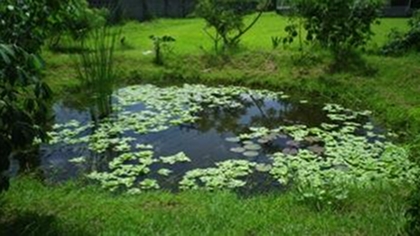SUMMARY
This is AI generated summarization, which may have errors. For context, always refer to the full article.
 Let me tell you a story.
Let me tell you a story.
One day, United Nations scientists announced that in 3 days, because of rapid climate change and an impending 20-meter sea level rise, there would be massive floods all over the world. The leader of the United States announced that in 3 days, they would build huge boats that will accommodate all of the 300 million people of America. Thus, they would all be saved. The leader of China announced that in 3 days, all 1.3-B people of China would evacuate to the high mountains of the Himalayas. Thus, they would all be saved.
The leader of the Filipinos went on tri-media and said, “My countrymen, the scientists tell us that after 3 days, we will all be underwater because of floods and a 20-meter sea level rise. My beloved countrymen, we still have 3 days to learn how to breathe underwater.”
Short of learning to breathe underwater, there is something that we Filipinos are geniuses at – resilience and adaptability. We only need proper guidance.
What causes flooding?
Many reasons have been given: improper drainage, improper garbage disposal, wrong (or no) land use planning, ongoing rapid climate change, etc. Those are all correct. But the bottom line of why there is flooding is really quite simple: Excess waters have nowhere to go.
Every problem contains within itself the seed of its own solution. The solution to flooding is really very simple: Give the excess waters a place to go. That is the function of wetlands, ponds, and lakes.
But what have we done? We have paved with concrete all available lands – including wetlands, low-lying, and flood-prone areas – and turned them into housing subdivisions and commercial centers. In other words, where there used to be water, we built our human settlements. And then we complain that there is water in the form of floods. Sino ang tanga d’yan? Ang tubig o ang tao?
New norm: excessive rainfall
The experts have been telling us that these floods will be the new norm. The sooner we accept that, the sooner we will be able to address its consequences.

The map above comes from the US National Aeronautics and Space Administration (NASA). It shows hottest ocean surfaces from 1993 to 2008. Note that the biggest patch of red (indicating the hottest body of water) is located west of the Pacific Ocean, right east of the Philippine islands. Scientific evidence shows that this hot water is the fuel of more frequent and more intense typhoons. In fact, this area is the “factory” where all our typhoons come from. With a hotter water temperature, there is greater evaporation of the water, and greater condensation of water vapor in the clouds. Because what goes up must come down, the heavier clouds come down as heavier rainfall.
In other words, let us accept the facts that:
-
There will more frequent, more intense, and more weird typhoons
-
Flooding, as a result of excess rainfall, is here to stay and will only get worse.
-
Unless we understand that, and learn to unleash the Filipino genius of resilience, we will be consigned to commit the same mistakes over and over and over and over and over again.
Solution to flooding
Again, why is there flooding? Because excess waters do not have a place to go. Solution: Find a place for it to go. How difficult can that be?
Government should therefore find vacant spaces, especially in low-lying areas, and excavate the land and turn it into ponds, water reservoirs, and lakes so that excess waters will have a place to go. It hurts to think that all government has been doing is to sell government lands for “development.” The FTI or Food Terminal Inc, with an area of 74 hectares, is now being sold to the highest bidder to turn into another commercial development. The Manila Seedling Bank, the last lung of Quezon City, was recently taken over by the local government supposedly for another commercial development. The same fate happened to the Alabang Stock Farm (now a commercial center), the Bonifacio Golf Course, the University of the Philippines in Diliman, etc. Even the remaining vacant lands in military reservations in the metropolitan area are planned to be sold to commercial developers.
Do we really need all these malls and commercial “development”? How much do we spend for “relief” efforts, how much is the damage and the cost of the lives that result from every flooding episode? Can we not set aside even a portion of those areas to catch excess rainwaters, and turn some of it into open spaces for parks and possible evacuation centers? Mr Gobyerno, hanggang pera-pera na lang ba talaga ito?
On Thursday, August 9, there was a special feature in a national newspaper titled “The Singapore Water Story: Turning Vulnerability into a Strength.” The city-state of Singapore has a land area of about 70,000 hectares (slightly larger than the Metro Manila’s 67,000 hectares). Because it was very vulnerable to an uncertain source of its freshwater, Singapore, tiny as it is, has devoted almost 70% (or almost 50,000 hectares) of its land into water catchment areas.
“Rainwater is collected through a comprehensive network of drains, canals, rivers, and stormwater collection ponds before it is channeled to Singapore’s 17 reservoirs for storage.
“Two-thirds of Singapore’s land is water catchment today.”
In my recent visit to Singapore, I was informed that they are nearing 70%.
By contrast, here we are, suffering from all these floods year after year, rain after rain. And yet, here we are, merrily selling off all the available government lands to commercial developers to be paved over with concrete – all in the name of dubious economic progress and development. And then we complain of floods?
In the words of a 20th century thinker, “doing the same thing over and over again and expecting a different result” is the exact definition of insanity.”
Rainwater catchment

The picture above is a 10-square meter rainwater pond that the author dug in the lowest part of a small patch of land south of Manila. It is a simple illustration of how a rainwater catchment pond looks like and what the benefits are:
-
Being on the lowest portion of the land, that is where water will naturally accumulate. By digging a hole there, the excess waters will have a place to go.
-
Since the bottom of this pond is unpaved with concrete (and would normally be permeable lime or sand and stones), the excess water is absorbed back into the ground to replenish the depleted groundwater table (aquifer).
-
It only costs P1,000 pesos of labor – two people digging for two days, and this is only half a meter deep. What if more people dug for more days? Or better yet, what it heavy equipment are used for larger areas? The work will certainly be accomplished much faster.
-
To prevent it from being a breeding ground for mosquitoes, populate it with fish. Then it becomes a source of protein. Also, frogs, which eat mosquito wrigglers by the hundreds, will normally populate these ponds.
-
To prevent it from being stagnant, put water lilies and water hyacinth – Nature’s amazing water cleansing and aeration mechanism. The roots of the water hyacinth suck in the dirt from the stagnant water and release dissolved oxygen.
-
Kangkong can also be planted on the shallow portions of the pond. Other vegetables and fruits (bananas, papayas, etc.) can also be planted along the banks. There is no reason why one in 5 of our people should be hungry-poor.
-
Bigger ponds and mini-lakes also provide a place for inexpensive recreation (fishing, boating, even swimming). Of course, a ready source of food.
-
These reservoirs will provide a source of water during the dry season.
-
Oh, by the way, it will also prevent flooding.
Over a year ago, I met with two high-ranking officials of the Aquino government. One promised to work with a supposedly progressive local government to showcase a rainwater catchment pond in its area. Whatever happened to this plan, only God knows. Is this not the same local government that has converted the Quezon Memorial into a parking lot? Brilliant!
The other official is from the department in charge of the conditional cash transfer program. I humbly suggested that instead of a pure dole-out, part of the condition can be for the recipients to work and put up rainwater catchment ponds in their localities.
I can only suggest. Whether people – especially those in positions of power – will listen to this ordinary man’s suggestion is beyond my control. What is certainly within our collective control are the ways by which we can prevent flooding.
Little ray of hope
The laws are in place. Republic Act 6716 dated March 1989 mandated the construction of 100,000 rainwater collectors in every barangay all throughout the country within two years, i.e. until 1991. In 1991, this power was devolved to the local governments (Rep Act 7160, Local Government Code). Of course, like many of the laws in this country, it lies atrophied in the sickbed of non-compliance.
In the aftermath of Ondoy, a group of citizens filed the first Writ of Kalikasan in the Supreme Court in April 2010. As a result, the Department of Interior and Local Government (DILG) and the Department of Public Works and Highways (DPWH) entered into a memorandum of agreement to implement the Rainwater Collector Law. This has been submitted to the Supreme Court for approval as a matter of compromise agreement (known in the Environmental Rules of Court as a “consent decree”).
A note on the present personalities in place:
The DPWH is now headed by a man who, in his private sector days with a water company, was responsible for putting up a huge rainwater collector in the Fort (Taguig), supposedly the size of a 7-storey building. No wonder the Fort does not flood.
The DILG is now headed by a former multi-awarded mayor of a region frequently visited by typhoons. He understands only too well the meaning of resilience and adaptation.
The Department of Agriculture is now headed by a sincere organic farming advocate. He has long practiced what he now preaches. The areas around the rainwater catchment ponds/reservoirs may well become showcases for urban (and organic) edible gardens.
The Bureau of Fisheries and Aquatic Resources (BFAR) is headed by an action-oriented environmental lawyer who knows what he is doing. He can very well stock the rainwater catchment ponds with appropriate indigenous aquatic life.
The Presidential Advisers on Environment, on Climate Change and the Vice Chair of the Climate Change Commission are all sincere and brilliant advocates who understand the benefits of rainwater catchment ponds.
The DENR, through its Mines and Geosciences Bureau, can pinpoint vulnerable lands that can be restored into wetlands or rainwater catchment reservoirs.
The Department of Budget is now headed by a man from a group of islands familiar with typhoons and the meaning of resilience. He can allocate funds for the acquisition of lands in low-lying areas to turn into water catchment ponds and reservoirs.
The DSWD is now headed by a well-known social entrepreneur who has her head, heart, and, if I may add, her hair, in the right place. With the conditional cash transfer (CCT) program in place, we can put millions of Filipinos to productive and sustainable work. It will not only to solve the flooding problem, it will also provide us water and feed our people for all time.
In other words, the stars are aligned with the right people in the right places at the right time. Every crisis is an opportunity. All it needs is guidance and the go-signal from our leader. With a fast-track action plan, we can minimize flooding by the rainy season of 2013, and altogether eliminate it by 2015.
Next steps
The leader can convene a meeting of these people tomorrow, and give them a deadline of 30 days to come up with an action plan that is to be implemented in the next 300 days. Yes, everything had to be done yesterday; no, it had to be done 30 years ago.
Mr President, you have the right people in the right place at the right time. You have the sincerity, the vision, and the will power to address this nagging and recurring problem. We have a full-blown crisis in our midst. We all know that it will only get worse, as we have seen year in and year out. We are running out of names of call our typhoons and flooding episodes. In fact, this time, we did not even have a name for it. We simply called it habagat. Imagine if we had that kind of rain in a full-blown typhoon? Why do we always have to sit on the brittle branch of disaster?
Mr President, you cannot teach us how to breathe underwater. But you can guide us to unleash the Filipino genius of resilience and turn this adversity into an opportunity. Yes, there is a simple solution to the flooding problem: Provide a receptacle for the excess waters.
“That is the difference between the obscure and the obvious. The obscure gets figured out sooner or later. It is the obvious that takes a lot longer.” – Rappler.com
(Editor’s note: Hailed as one of Asia’s leading voices on environmental law, Antonio Oposa Jr is a 2009 Ramon Magsaysay Awardee. He has solved the problem of flooding in his place in Bantayan Island, Cebu, by simply providing a pond to collect excess rainwater and allow it to settle. He also illustrates the concept in a small rainwater catchment pond in a vacant lot in front of his house south of Manila.)
Add a comment
How does this make you feel?
There are no comments yet. Add your comment to start the conversation.